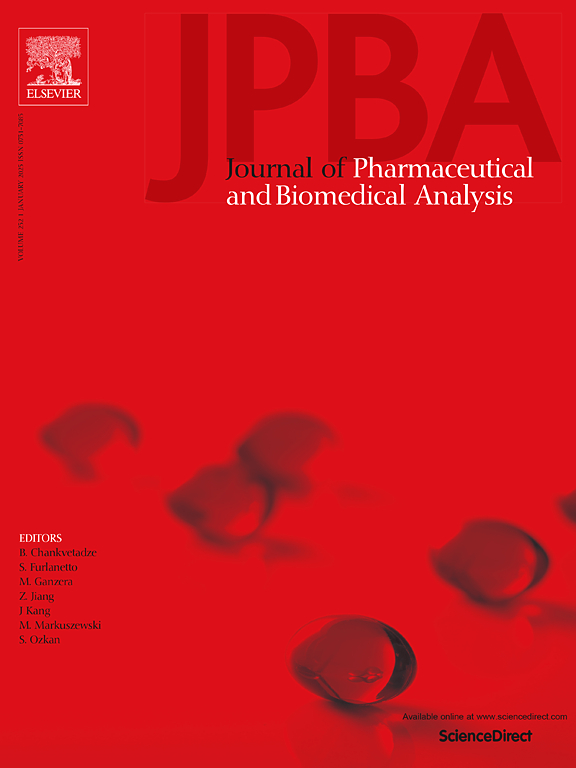Development and validation of a UPLC-MS/MS method for almonertinib with its active metabolite HAS-719 and anlotinib in human plasma
IF 3.1
3区 医学
Q2 CHEMISTRY, ANALYTICAL
Journal of pharmaceutical and biomedical analysis
Pub Date : 2025-02-24
DOI:10.1016/j.jpba.2025.116766
引用次数: 0
Abstract
Almonertinib and anlotinib are tyrosine kinase inhibitors used to treat malignant tumors, with their combination currently applied to non-small cell lung cancer (NSCLC) patients. This study aimed to develop a simple and rapid UPLC–MS/MS method for simultaneously detecting almonertinib, its active metabolite HAS-719, and anlotinib in human plasma. The analytes were separated on a Waters HSST3-C18 column following protein precipitation with acetonitrile. Mass detection was performed on a Waters TQS triple quadrupole mass spectrometer under positive electrospray ionization mode. The MRM ions were m/z 526.5→71.96 for almonertinib, m/z 512.4 → 455.41 for HAS-719, m/z 408.16→ 339.03 for anlotinib and m/z 518.5→372.26 for d6-HAS-000719 (internal standard). Method validation followed FDA guidelines and Chinese Pharmacopoeia regulations, demonstrating acceptable accuracy, precision, matrix effects, recovery, and stability. The method showed excellent linearity over 0.5–500 ng/mL for all three analytes, with correlation coefficients (r²)≥ 0.99. The validated UPLC-MS/MS method successfully monitored almonertinib and anlotinib concentrations in clinical, particularly for NSCLC patients.
求助全文
约1分钟内获得全文
求助全文
来源期刊
CiteScore
6.70
自引率
5.90%
发文量
588
审稿时长
37 days
期刊介绍:
This journal is an international medium directed towards the needs of academic, clinical, government and industrial analysis by publishing original research reports and critical reviews on pharmaceutical and biomedical analysis. It covers the interdisciplinary aspects of analysis in the pharmaceutical, biomedical and clinical sciences, including developments in analytical methodology, instrumentation, computation and interpretation. Submissions on novel applications focusing on drug purity and stability studies, pharmacokinetics, therapeutic monitoring, metabolic profiling; drug-related aspects of analytical biochemistry and forensic toxicology; quality assurance in the pharmaceutical industry are also welcome.
Studies from areas of well established and poorly selective methods, such as UV-VIS spectrophotometry (including derivative and multi-wavelength measurements), basic electroanalytical (potentiometric, polarographic and voltammetric) methods, fluorimetry, flow-injection analysis, etc. are accepted for publication in exceptional cases only, if a unique and substantial advantage over presently known systems is demonstrated. The same applies to the assay of simple drug formulations by any kind of methods and the determination of drugs in biological samples based merely on spiked samples. Drug purity/stability studies should contain information on the structure elucidation of the impurities/degradants.

 求助内容:
求助内容: 应助结果提醒方式:
应助结果提醒方式:


